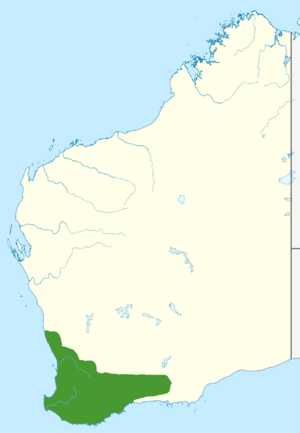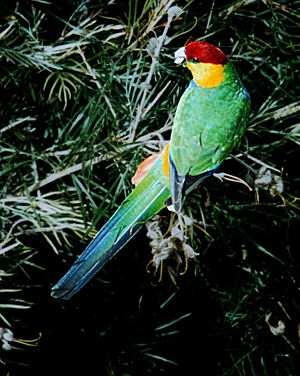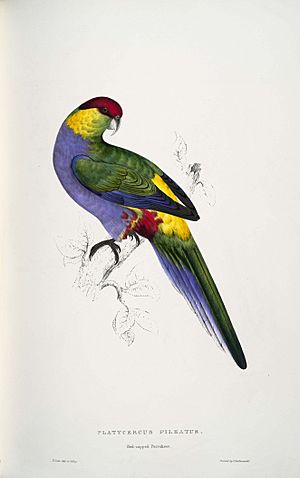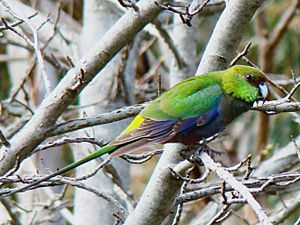Red-capped parrot facts for kids
Quick facts for kids Red-capped parrot |
|
|---|---|
 |
|
| Adult, Albany, WA | |
| Conservation status | |
| Scientific classification | |
| Genus: |
Purpureicephalus
|
| Species: |
spurius
|
 |
|
| Range in green | |
| Synonyms | |
|
Psittacus spurius Kuhl, 1820 |
|
The red-capped parrot (Purpureicephalus spurius) is a colorful bird found in southwest Western Australia. It was first described in 1820. This parrot is special because of its unique long beak. Scientists have studied its DNA and found that it is related to the Psephotellus parrots, with its closest relative being the mulga parrot.
This parrot is easy to spot! It has a bright red top of its head, green-yellow cheeks, and a long, special beak. Its wings, back, and long tail are dark green, and its belly is a pretty purple-blue. Female parrots look very similar to males, but sometimes their colors are a bit duller. A key way to tell them apart is a white stripe under the female's wing. Young parrots are mostly green.
Red-capped parrots live in woodlands and open savanna areas. They mostly eat plants, especially seeds from eucalypt trees, as well as flowers and berries. Sometimes, they also eat insects. They build their nests in tree hollows, usually in large, old trees. Even though they have faced challenges like being hunted and losing their homes due to land clearing, their numbers are growing. Because of this, the International Union for the Conservation of Nature (IUCN) considers them a species of least concern.
Contents
What is the Red-Capped Parrot's Scientific Name?
The red-capped parrot was first described in 1820 by a German naturalist named Heinrich Kuhl. He called it Psittacus spurius. The word spurius means "illegitimate" in Latin. Kuhl chose this name because young parrots look very different from adults, almost as if they were not related!
Later, in 1854, a French biologist named Charles Lucien Bonaparte placed this parrot in its own special group, or genus, called Purpureicephalus. This name comes from Latin and Ancient Greek words meaning "purple head." The parrot's unique long beak and its special colors (without the cheek patches seen in other similar parrots) are why it has its own genus.
Currently, scientists do not recognize any different types or subspecies of the red-capped parrot. This means all red-capped parrots look pretty much the same across their range.
How is the Red-Capped Parrot Related to Other Birds?
Scientists have long wondered how the red-capped parrot fits in with other broad-tailed parrots. A genetic study in 2011 looked at the parrot's DNA. It found that the red-capped parrot is closely related to the mulga parrot. These two parrot groups separated a long time ago.
The official name for this bird is "red-capped parrot," given by the International Ornithologists' Union. People have also called it "red-capped parakeet" or "western king parrot." In the Noongar language, spoken by Indigenous people in the southwest region, it has names like Djar-rail-bur-tong and Djalyup.
What Does the Red-Capped Parrot Look Like?
The red-capped parrot is known for its bright and clear colors. It is a medium-sized parrot, measuring about 34 to 38 centimeters (13 to 15 inches) long. Its wingspan is around 42 to 48 cm (17 to 19 in), and it weighs about 105 to 125 grams (3.7 to 4.4 ounces).
The adult male has a bright crimson red forehead and crown. This red color extends from its beak to its eyes. Its neck and cheeks are green, and its ear feathers are more yellow-green. The top parts of its body, including its wings, are dark green. Its lower back is yellow-green, and its tail is green with a dark blue tip. The parrot's belly is a purplish-blue. Its sides are green and red. The parrot's eyes are dark brown. Its beak is pale blue-grey with a dark grey tip. The upper part of its beak is long and hooked.
Differences Between Male and Female Parrots
The female parrot looks similar to the male, but her colors are usually a bit less bright. The red on her head is not as strong, and her red sides might have some green and yellow spots. Her chest is more greyish-violet than purple. When she flies, you can often see a whitish stripe on the underside of her wing. This stripe is a good way to tell females apart from males.
How Do Young Parrots Change?
Young parrots are mostly green when they are born. They start to change their feathers around August. After this, their feathers look much more like adult birds. Their crown starts dark green with a reddish band. Their chest becomes grey-violet like the female, and their belly has red and green patches. Their beak is more orange at first, but it turns pale blue-grey like the adults by two to five months old.
What Do Red-Capped Parrots Sound Like?
The red-capped parrot makes a quick, repeated sound like krukk-rak or crrr-uk. When they are alarmed, they make a series of loud, high-pitched notes. Male birds chatter loudly when they are upset or protecting their nest area. Baby parrots and young birds that have just left the nest make a high-pitched, two-syllable sound to ask for food.
Where Do Red-Capped Parrots Live?
The red-capped parrot lives in the Southwest Australia ecoregion. They can be found in thick or open forests, woodlands, and heathlands near the coast. Their range extends from the Moore River south to the coast near Esperance. They usually stay within 100 kilometers (62 miles) of the coastline.
They prefer eucalypt forests and woodlands. They are especially found where marri trees (Corymbia calophylla) grow. Marri trees provide a steady food source for them. They also live in areas with other trees like jarrah, tuart, wandoo, yate, and peppermint. Since they eat seeds, they are also seen in farmlands, orchards, and gardens in cities like Perth.
Red-capped parrots can be affected when land is cleared and trees are removed. However, they are often seen in lake reserves in suburban areas. They are common at places like Forrestdale and Thomsons Lakes Ramsar Site and Bibra Lake. They also live in the Dryandra Woodland, which has many jarrah and marri trees.
How Do Red-Capped Parrots Behave?
Red-capped parrots are usually seen in pairs or small groups of 4 to 6 birds. Sometimes, larger groups of 20 to 30 birds can be found. Very rarely, a flock of up to 100 birds might be seen, usually made up of young parrots. They sometimes hang out with Australian ringneck parrots or western rosellas.
These parrots are quite shy. If they are disturbed, they often fly up to the highest branches of trees. This shyness makes it hard for scientists to study their breeding and social lives, so many things about them are still a mystery.
Reproduction and Life Cycle
Red-capped parrots are believed to stay with one partner for a long time, forming pairs around 20 months of age. The breeding season is from August to December.
They need mature trees with large hollows in their trunks or branches for nesting. These trees can be found along roads, near water, in fields, or in forests. Nests are usually 50 to 100 meters (160 to 330 feet) apart. Pairs strongly defend their nests from other birds, especially other red-capped parrots.
The nest is typically in a hollow of an old, large tree like a marri or jarrah. It is usually 4.5 to 16 meters (15 to 52 feet) above the ground. The hollow is lined with wood dust. The female lays a clutch of usually five, sometimes six, white eggs. Each egg is about 28 x 22 millimeters (1.1 x 0.87 inches). The female sits on the eggs to keep them warm. The male stays nearby and brings her food. The eggs hatch after about 20 to 24 days.
Baby parrots are born weighing 4 to 6 grams (0.14 to 0.21 ounces). They are covered in white down, which soon turns grey. Their eyes open when they are 9 to 11 days old. They stay in the nest for 30 to 37 days, usually all leaving on the same day. Their parents continue to feed them for another two weeks after they leave the nest.
What Do Red-Capped Parrots Eat?
Red-capped parrots love to eat marri seeds. They also get seeds from other trees like karri, woody pear, Grevillea, Hakea, dryandra, and sheoak. Their special beak allows them to get seeds out of tough eucalypt capsules. They can also eat the unripe fruit of marri trees. They sometimes eat green seeds from grasses like wild oats and acacia. They also look for nectar in flowers like kangaroo paws. Any seeds they eat but don't digest can help spread new plants.

They also eat some introduced plants, like the seeds of slender thistle and variegated thistle. They have learned to eat fruit from orchards, such as apples and pears, and from suburban gardens. They often bite into red-skinned apples to get the seeds inside. They don't eat the apple flesh but squeeze it to drink the juice. They also eat almonds, nectarines, olives, peaches, plums, pomegranates, and white cedar. Insects like psyllids, their larvae, and lerp are also part of their diet, especially in late winter and spring during their breeding season.
Red-capped parrots mostly feed on the ground. They hold a eucalypt capsule or sheoak cone with one foot and use their slender hooked beak to get the seeds out. They are very skilled at using their foot and beak to get seeds. They leave shallow marks around the opening of the seed capsule, showing how they feed. Most red-capped parrots use their left foot to hold and manipulate objects.
Are Red-Capped Parrots Protected?
In the past, red-capped parrots were sometimes shot because they were seen as pests that damaged fruit crops. However, studies have shown that the damage they caused was not significant. Despite being hunted and losing some of their habitat, their population is actually growing. This might be because some areas have changed in a way that creates more suitable homes for them.
Because their population is growing and they have a large range, the International Union for the Conservation of Nature (IUCN) considers the red-capped parrot a "least-concern species." This means they are not currently at risk of extinction.
Can Red-Capped Parrots Be Kept as Pets?
With their beautiful colors, red-capped parrots are attractive birds to keep. However, they are known for being anxious when kept in captivity and can be difficult to breed. This might be because many of the birds kept in the past were caught from the wild. The first successful breeding of these parrots in captivity happened in England in 1909.
Images for kids
-
An adult red-capped parrot eating Grevillea seeds.
See also
 In Spanish: Perico capelo para niños
In Spanish: Perico capelo para niños











